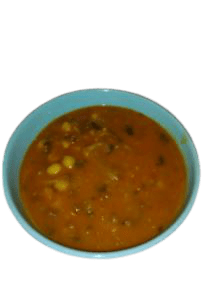Egyptian Chicken molokhiya
Author: Marisa Lopez
Molokhiya is also known as jute in English. It’s served as a thick soup with rice (called “roz” in Arabic) and it’s usually served with chicken or rabbit. Molokhiya with roz is a very common dish prepared at home across several different Arab countries. The Lebanese make molokhiya slightly different from the Egyptians, as well as Palestinians.
The origins of the dish are said to be in ancient Egypt, where it’s still popular to this day. In the Egyptian preparation, the Molokhiya leaves are stripped from the stems, then minced using a mezzaluna. It’s cooked with ground coriander, garlic and stock and is often served with chicken (or more traditionally rabbit). In Levantine countries such as Syria and Lebanon, Molokhiya is made with the whole leaves and is served with a vinegar and onion sauce along with toasted pita squares.
I share my recipe which is the traditional Egyptian one :
Ingredients
For the broth :
- 1 whole chicken
- Water
- 1 whole onion and 1 whole carrot
- Cumin, salt and pepper and cardamom
For the molokhiya and tasha :
- You can use fresh or frozen minced molokhiya. Fresh molokhiya gets better results in taste and consistency but frozen one can work well also.
- 1 whole head of garlic or about 14-16 garlic cloves
- Ground coriander, salt and pepper
- Ghee
For the Egyptian rice with vermicelli:
- 2 cups of Egyptian rice
- Half cup of vermicelli
- Olive oil or ghee
- Salt and peppet
- Water or broth
Grilled chicken
- Our previous cooked chicken
- Cumin, Tomato paste, yoghurt, olive oil salt and pepper
Elaboration
- The first step is boiling the chicken, onion, cumin, and cardamom. I boil the chicken on high for 45 minutes. Reduce to medium-low and cover with a lid for another 45 minutes. The total cooking time for the chicken broth is around 1 hour and 30 minutes. The reason for cooking the chicken in water is to be able to use the broth for the molokhiya and rice. A secondary benefit is that the chicken is very tender!
- Cook the molokhiya (fresh or frozen) in the chicken broth
- Prepare the tasha : Peel and cut off the ends of the garlic. Smash with salt with a mortar and pestle or chop the garlic into fine pieces with dried coriander and salt to get a paste. Fry this garlic paste using a non-stick skillet.
- Add the fried garlic with the coriander to the cooked molokhiya and remove from the fire.
- Prepare the rice. In a pan, heat 1 tablespoon of olive oil or ghee and add half cup of vermicelli and cook it in the oil until it gets golden color Add the rice and mix well and add the water or broth and salt and pepper. Cook for 20 minutes
- Grill the chicken covered with the mix of yoghurt, tomato paste, cumin, olive oil and salt and pepper
Recent Posts:
Amirazz: The Muslim App That’s Changing the Game for Women
- Navigating Financial Independence: Essential Tips for Young Adults
- The Importance of Mental Health in Marriage: An Islamic Perspective
- Eco-Elegant Nuptials: How to Plan a Stylish and Sustainable Wedding
- Modern Matrimony: Tech Tools to Perfect Your Wedding Planning Process
Zencortez
Zen cortex
Zencortex review
It’s not my first time to pay a quick visit this website, i am browsing this site dailly and get…







Thanks for one’s marvelous posting! I really enjoyed reading it, you happen to be a great author.I will be sure…